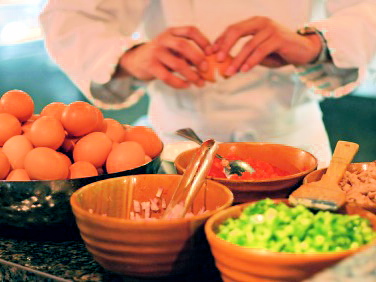
feature-image, l
(article, Ashley Griffin Gartland)
[%pageBreakSettings nobreak=true] [%adInjectionSettings noInject=true] When I signed up for a hands-on cooking class titled “Oregon Coastal Brunch,” I didn’t even consider planning ahead. I assumed the class would feature a chef, cloaked in a starchy white jacket, who would discuss kitchen methodology and share culinary tips. I hoped I’d be sharing the test kitchen with other novice cooks, so I wouldn’t feel intimidated, and that we’d all feel proud and excited when the instructor finally called out, “Brunch is served!” But all I really knew for certain was that I was supposed to bring an apron. What I didn’t know the day before my first cooking class could have filled the front and back of a very large recipe card. On the appointed day, aprons in hand, my boyfriend and I strolled into the gourmet cooking store hosting our class. I quickly realized we were 30 minutes early, and the first to arrive; thankfully, the staff supplied us with complimentary mimosas and invited us to explore the store, drinks in hand. The shop featured ample eye candy for browsing, and the half hour passed quickly. But in a traditional classroom setting, we would have twiddled our thumbs, regretting our early arrival. [%image promo-image float=right width=400 caption="Cooking school is open." credit="Photo: iStockphoto/joebrandt"] Lesson 1: Be prompt, but not overly so. As the rest of the students trickled in, I overheard many lamentations of unpreparedness. One girl chastised her boyfriend for forgetting aprons, while a silver-haired woman approached the instructor and announced her potent allergy to strawberries. The poor instructor was forced to restructure his menu just minutes before class began. Lesson 2: If you have special dietary needs, or are expected to bring equipment of your own to the class, confirm both in advance. You’ll arrive feeling prepared, not apprehensive. [[block(sidebar). h1. Do your homework Cooking teacher Allyson Holt, of Allyson’s Kitchen in Ashland, Oregon, has three tips for ensuring a worthwhile class experience: 1. Check out the school: Is it new or venerable? Ask for references and a copy of the curriculum to make sure the classes are a good fit for you and your skill set. 2. Be flexible. The popular hands-on classes don’t always yield the greatest level of understanding, and they can be a bit overwhelming for novice chefs. “Students may want to consider a demonstration class first, and then attend a hands-on workshop after they are comfortable with the classroom and the teacher,” says Holt. 3. Read the menu and class descriptions. Both give hints about food types, techniques, and the instructor’s background and teaching style. ]] Once the instructor had settled the menu change, we gathered around the stately test kitchen. The instructor opened the three-hour class with a summary of his cooking background and the forthcoming menu. Interesting, yes, but as he continued to hold forth, it became awkwardly obvious that his pace was too languid. Many students had clearly been fasting all morning in order to fully indulge in the course’s brunch menu. But at a hands-on cooking class, the food doesn’t miraculously appear at the snap of the chef’s fingers. We would eat, but only after cooking for a few hours. Lesson 3: Eat a pre-class snack to tide you over until the dishes are served. After the introductory section, our instructor assigned each dish to a pair of students and proceeded to work the room, bouncing from pair to pair, answering questions. But there was only one instructor, and too many questions. The solution? Flagging down the assistant instructor. Ours taught us how to cut away the peel and pith of an orange before pulling fruit segments from between the membranes. Later, he also showed us the best way to make egg whites form stiff peaks. Lesson 4: The head instructor isn’t the only knowledgeable chef in the room. Ask the assistant instructor for help, or your neighboring students. Midway through our slicing, dicing, and stewing, an etiquette issue began to plague me: Can I sample the foods while cooking? For me, not sampling is a challenge comparable to climbing Mount Kilimanjaro — especially after the instructor placed four bowls of bright, shiny dried figs, cherries, and pears before me. I stopped short of snacking only when I recalled that I wasn’t in my home kitchen. Fortunately, the instructor soon started encouraging us to sample. By doing so, he said, we would discover new flavors and be able to tell when our dishes were ready to serve. Lesson 5: Taste-testing is appropriate only when encouraged and the ingredients are plentiful. A few taste-tests later, our instructor invited us to line up at the buffet. We quickly dished up and devoured our first plates of hazelnut waffles, Jerusalem artichoke latkes, and smoked salmon and asparagus frittatas. For a few minutes I sat quietly, contemplating one last looming question: Does it look too greedy to head back for seconds? [[block(sidebar). h1. Featured recipes]] A few moments later, student after student pushed back from the table and returned to the buffet. Not only were seconds acceptable; indulging was a compliment to both the chef and the students. Lesson 6: After you’ve labored in the kitchen, you have the right to dig in — especially more than once. p(bio). Ashley Griffin Gartland is a Portland-based food writer and the executive director of the Portland Culinary Alliance. Elsewhere on Culinate: A review of a book about chefs learning to cook and an article about culinary boot camps.

feature-image, l

featurette-image, l

promo-image, l

reference-image, l